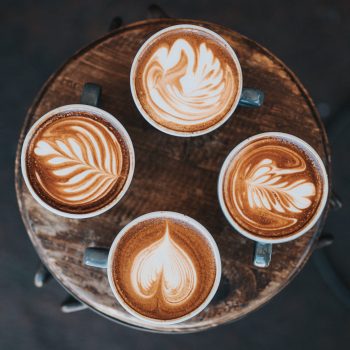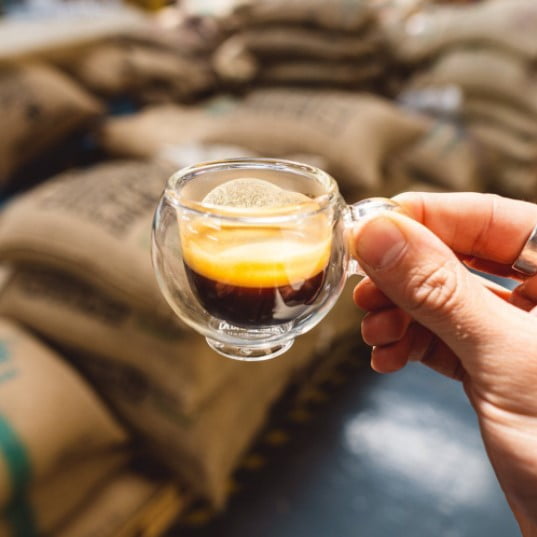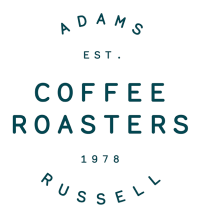Types of coffee drinks – an explanation, how to make them & their history
- Last Updated:

This guide is designed to take you through the typical coffee shop menu, explaining the different types of coffee drink and a little about their origin.
The world of coffee is growing every single day, and it’s often hard to keep up with the latest inventions seen on the busy high streets. Nitro cold-brew may not be your thing so we have kept this guide simple and will explain the more traditional drinks you would expect to find.
After reading this guide you will:
- Understand what the most popular espresso-based drinks are.
- Have an insight into how they are made.
- Know the history behind them and how they came about.
All of the beverages explained are espresso based, meaning a double shot espresso is the base of each drink. Although some very fine coffees can be extracted using hand-brew methods, this post is related to the drinks you would expect to find in a coffee shop.
Click here to find out more about our signature Continental Blend coffee
Cappuccino
What is a cappuccino?
It’s one of the best-known hot drinks on the High Street, and it’s made up of three parts; espresso, steamed milk and milk foam. It contains the most voluminous foam that provides a perfect texture when combined with the espresso. Careful attention is needed when making a cappuccino in order to achieve this luxury.
How to make a cappuccino
- Prepare the espresso.
- Cold milk is stretched in the steam jug. Stretching is the term given to continuously adding air to the milk until it is lukewarm.
- Turn the steam wand off when the milk jug is too hot to touch. Giving the desired temperature of 65-70 degrees.
- Rotate the jug to prevent the milk and foam separating.
- Pour from a low height onto the espresso, ensuring enough foam enters the cup.
A cappuccino is usually a short drink and is usually 8oz in size. The closer the temperature is to lukewarm the sweeter milk is, making it ideal for those who gulp their coffee.
Where does the cappuccino originate from?
When coffee was first discovered, it was brewed in a pretty simple way known as the ‘Ottoman’ style. This consisted of boiling coffee in water with the occasional addition of sugar to make it more pleasant. By the late 18th century, parts of Europe began to filter their coffee for a much smoother drink. With the addition of cream and sugar in Viennese coffee houses, the term ‘cappuccino’ was created. ‘Capuchin’ translates to hood or cloak, and, at the time, the monks of Vienna wore brown robes which were a similar colour to the cappuccinos. This is how the now world-renowned drink received its name.
Caffe Latte
What is latte coffee?
A latte consists of the same three parts as a cappuccino (espresso, milk foam and steamed milk), but the ratio is what differentiates this drink. The majority of a latte is made up of steamed milk, and only a very small amount of foam is added. The steamed milk used in this drink is also much smoother than a cappuccino and contains less air.
How to make a latte at home
Think you have to venture to the nearest café for your creamy latte fix?
Think again. We’re going to tell you how to enjoy the smoothness of a latte in the comfort of your own home.
Other than your usual brewing devices, all you need is a French press and a microwave.
- Brew an espresso using a stove top espresso maker.
- Pour cold milk into a French press base and microwave on a low setting for 30 seconds.
- Repeatedly plunge to French press through the milk, catching the air and adding it to the lukewarm milk. The more you plunge the smoother the milk will be.
- Pour the milk onto the espresso.
Latte history – where did it originate?
The addition of milk into coffee has been around since the 17th century when the stimulating effects of coffee were required but without the bitterness.
The distinction between cappuccino and latte, as the two have developed, is unclear, as they are so similar. In 1867, the term ‘caffè latte’ was used in novelist, playwright and literary critic William Dean Howells’ essay “Italian Journeys”, which was the first recorded use of the term in the English language.Since then, countries all over the world have applied their own adaptations to the drink. For example, in Spain, ‘café con leche’ (coffee with milk) is a popular drink.
Espresso
What is an espresso?
An espresso is coffee brewed at the highest pressure on an espresso machine. Water passes through the coffee bed and the grind size and dose of coffee needs to be set so that 9 bars of pressure can be attained. This will ensure that the water passes through in the correct amount of time to avoid under or over extraction. Under extracted espressos and very weak, with a cloudy colour and sour taste. This is when the water has passed through too quickly. Alternatively, coffee can taste very bitter and ashy, undesirable flavours like this is when the water has over cooked the coffee and passed through too slowly. Although preparing an espresso takes a lot of attention to detail, the main ‘recipe’ used can vary depending on what coffee you’re extracting. Typically, 18g of coffee is entered into the ground basket, and the overall weight of the espresso should be at least double that – 36g. Pulling a longer shot will dilute the coffee somewhat but could in fact help it to extract and reduce acidity.
How to make espresso without a machine
We’re going to be honest with you…homemade espresso without a machine won’t be the same as your local coffee shop order. It will be similar, and still a delicious, rich and strong drink, but not the same as a coffee machine espresso shot. But if you want to start enjoying homemade espressos, rather than relying on a barista, here’s how to do it using an aeropress…
- Finely grind some coffee and add to the Aeropress.
- Add boiled water onto the coffee just above the number 2 mark.
- Immediately begin to plunge, the pressure will be greater due to the fine grind size.
- Push all of the water out through the filter.
Espresso history and origin – where it all started…
Angelo Moriondo was the first person to patent the design of his ‘steam-driven instant coffee beverage making device’ in 1884. It is said to be one of the earliest discoveries of the espresso machine. However, it was nothing like the machines we are used to in modern times. It only brewed in bulk, rather than individual shots, which was a slight inconvenience for individual use. In 1901, Luigi Bezzera made many improvements on this initial design and patented them, which he later went on to sell. Since then, espresso has become the base of many coffee beverages, and its popularity grew rapidly throughout the 1990s in the UK.

Americano
What is an americano?
An americano is a shot of espresso with hot water. It is often confused with filter coffee, but the two are very different. An americano is simply made with an espresso shot from an espresso machine and hot water. Filter coffee is made through a filtering process, such as Aeropress, Kalita, V60 drip method, Chemex or any other device that uses a filter.
How to make the perfect americano
To make an americano, simply follow the steps to brew an espresso shot and add hot water. However, there is a very important step to achieving the perfect americano. The hot water should be poured into the mug first, and then topped off with a single or double espresso shot. By doing this the crema remains on top of the water, the crema holds a lot of flavour and also adds to the overall look or the drink.
Americano coffee history
In Italy, the term ‘caffè Americano’ translates to ‘American coffee’. Although it isn’t officially confirmed, it is believed that the americano derived from the Americans during World War II. When in Italy, the American soldiers diluted espressos with hot water to create a drink that they were more familiar with.This is where the term ‘americano’ was created, and it has stuck ever since.
Flat white
What is a flat white coffee?
A flat white is a similar drink to a caffe latte but has a different ratio, resulting in a stronger taste. A latte is usually served in a 8-10oz cup but a flat white is served in a 6oz. Therefore the ratio is around 1:3 coffee to milk.
How to make a flat white coffee
The milk served with a flat white is the same as a latte, some argue that it should be served cooler however we believe that all milk should be around 65 degrees. This is close to the temperature of the espresso which creates a silky texture when the two are mixed. It is vital to tap the jug on a hard surface when the milk has been steamed to eliminate large bubbles and create an ultra-smooth, glossy texture to the liquid.
The milk is poured on top of the coffee from a height so that it falls under the crema. After it is more than two thirds full the jug is lowered so that a small layer of foam can be added. This is also the moment in which latte art can be produced.
Where does a flat white come from?
There is a lot of debate as to whether the flat white was invented in Australia or New Zealand. The two countries both claim the credit for this wonderous creation. We’ll give you both sides of the story, so you can make a decision for yourself…
Local Australian Alan Preston claimed he coined the term on his menu board after gaining inspiration from Queensland. He saw many adverts for “white coffee – flat” which then prompted him to add ‘flat white’ to his offerings. He claims he invented the term in the 1980s.
New Zealand’s version of events starts with former barista Frank McInnes. He said the invention of a flat white was an accidental discovery after he served his customer a mediocre cappuccino. He failed to froth the milk, so apologised to the customer and stated: ‘Sorry, it’s a flat white’.
Which story do you believe?
Mocha
What is a mocha coffee?
A mocha is simply an espresso-based drink with the addition of chocolate.
It could be any of the beverages on this list with some form of chocolate added. This could be powdered chocolate, syrup, shavings or any other kind of chocolate flavouring.
How to make a mocha
The great thing about mochas is that they are designed for customisation. You can make it any way you like, but here’s an easy method you can recreate at home:
- Prepare the espresso and add chocolate to the shot. Chocolate powder works well with this method.
- Cold milk is stretched in the steam jug. Stretching is the term given to continuously adding air to the milk until it is lukewarm.
- Turn the steam wand off when the milk jug is too hot to touch. Giving the desired temperature of 65-70 degrees.
- Rotate the jug to prevent the milk and foam separating.
- Pour milk onto the espresso, ensuring enough foam enters the cup.
History of mocha coffee – where it originated…
You may have asked yourself, what does ‘mocha’ mean and what has it got to do with chocolate? The term ‘mocha’ originates from a variety of coffee that is grown in Yemen. Mocha beans were named after the Mokha port that they were shipped from in this Middle East country. Locals used to inquire what the unusual chocolate tasting bean was, a taste that is often attributed with arabica even to this day. As chocolate become more common throughout Europe, many countries began to add it to coffee for a delicious, sweet taste.
Macchiato
What is a macchiato?
A macchiato is a double shot of espresso with a dollop of steamed milk placed on the surface. Some baristas may put a little foam on top of a macchiato, but it will only be a minimal amount as a macchiato is designed to showcase the true flavours of the espresso.
How to make a macchiato
To make a traditional macchiato, you will require an espresso machine and a steaming wand. Here are the steps a barista follows to brew your magical macchiato…
- A single espresso shot is brewed into a small macchiato glass.
- The milk is steamed the same way it would be for a cappuccino.
- The jug is tapped on a hard surface and swirled to remove any large air bubbles.
- Spoon one or two dollops of foamy milk directly on top of your espresso shot.
These steps can be customised, depending on your preferences.
Macchiato origin – the history behind the drink…
‘Macchiato’ literally translates to ‘spotted’ in Italian. In Portugal, this beverage is referred to as ‘café pingado’, which translates to ‘coffee dripped’. Disregarding ratios, the premise of a macchiato is coffee with a drop of milk on top. The drink originated from the demand for espresso with just a tiny bit of milk. Italian baristas referred to it as ‘spotted’ or ‘marked’, to express the visual difference, and the name ‘macchiato’ has been associated with this beverage ever since.
Iced coffee
What is iced coffee?
Iced coffee is a chilled beverage that is usually served over ice. There are so many different adaptations of this drink that it is difficult to give just one definition.
Examples of iced coffee include iced latte, Vietnamese iced coffee and Delgado. Milk, condensed milk, sweetener, water, and other accompaniments can be used to customise this icy beverage.
How to make iced coffee at home
Iced coffee is a refreshing treat we enjoy all year round, who says it’s just for summer?
Whilst an iced americano is a cool way to appreciate the true flavours of your beans, we can’t resist some sweet flavourings every now and again.
Once you have mastered brewing your own espresso shot at home using an aeropress, making your own iced coffee creations will be a breeze… and actually pretty fun!
- Add some ice cubes to a glass.
- Pour over one shot of cooled espresso.
- Top up with milk to your desired strength.
Find three more fantastic recipes in our guide to flavoured iced coffee.
History of iced coffee…
Mazagran is believed to be the first example of iced coffee. It is a sweet drink that combines espresso, lemon, mint and rum. This drink originated in 1840 and is described as the ‘original iced coffee’.
Frozen coffee drinks were experimented with throughout the 19th century, often referred to as ‘café frappé’. Documentation of brewed coffee that is then chilled with ice appears in the late 19th century, which suggests that this is when the discovery was made.

